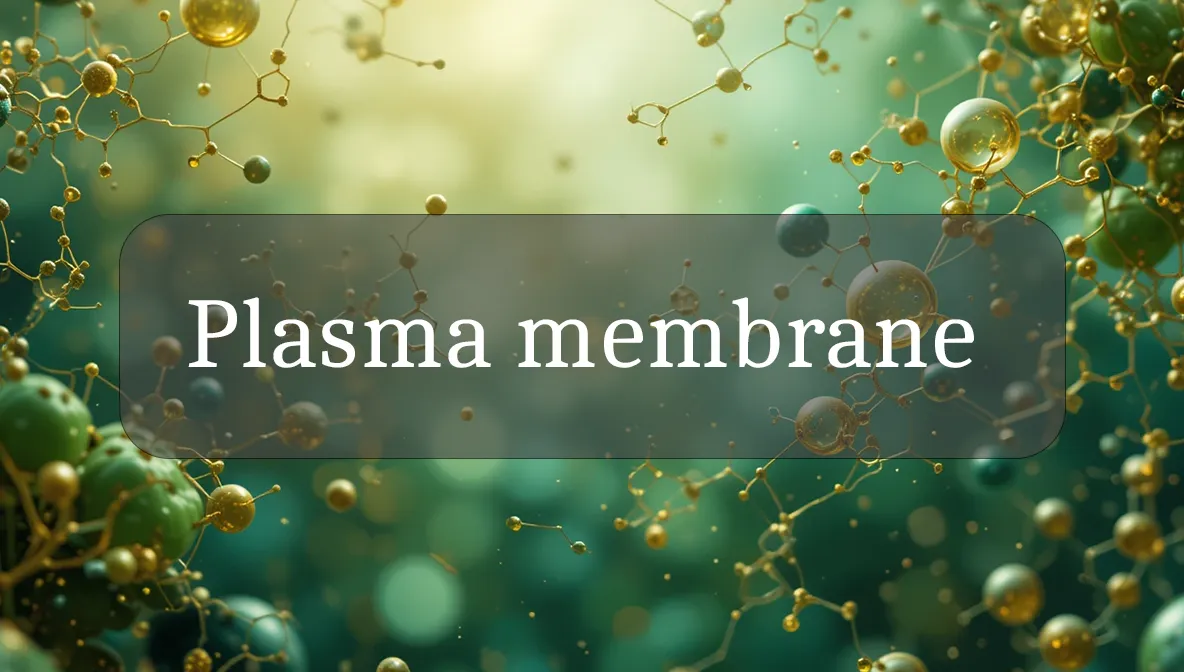Cells’ Gatekeeper for Health and Energy
The plasma membrane is like a smart security system for your cells, controlling what goes in and out to keep your body energized, protected, and thriving. This thin, flexible layer surrounds every cell, acting as a barrier and communicator that supports everything from nutrient uptake to immune defense. Whether you’re aiming for glowing skin, steady energy, or a strong immune system, understanding the plasma membrane can inspire you to nurture your cellular health. Let’s dive into why this cellular superstar matters and how to keep it thriving for a vibrant you.
Identity and Function
The plasma membrane is a double layer of lipids (fats) with embedded proteins that surrounds every cell in your body. Think of it as a selective gatekeeper, made of a phospholipid bilayer that’s fluid yet sturdy, allowing it to flex and move. It controls the flow of nutrients, waste, and signals, using proteins as channels, pumps, or receptors. The plasma membrane also anchors the cell’s shape, communicates with other cells, and protects against harm, making it essential for cellular life and function.
Biological Role and Health Impact
The plasma membrane is a cornerstone of your body’s vitality, with powerful benefits:
- Nutrient Uptake: It allows glucose, amino acids, and other nutrients to enter cells, fueling energy, growth, and repair.
- Waste Removal: It expels toxins and waste, keeping cells clean and preventing damage.
- Cell Communication: Receptors on the membrane receive signals from hormones or immune cells, ensuring cells respond to your body’s needs, like insulin regulating blood sugar.
- Immune Defense: It displays markers to help immune cells recognize “self” versus invaders, supporting infection resistance.
- Tissue Health: By maintaining cell integrity, it keeps skin, muscles, and organs strong, promoting glowing skin and resilience.
A healthy plasma membrane keeps your cells functioning smoothly, supporting energy, immunity, and protection against diseases like diabetes or infections.
Supporting Health
You can’t directly boost the plasma membrane, but you can support the cells that depend on it:
- Eat a Nutrient-Rich Diet: Include healthy fats (e.g., avocados, salmon) and antioxidants (e.g., berries, spinach) to build strong membranes and protect them from damage.
- Stay Hydrated: Drink 8–10 cups of water daily to keep cells plump and membranes fluid, aiding nutrient transport.
- Exercise Regularly: Moderate activity (e.g., 150 minutes of walking or yoga weekly) boosts circulation, delivering nutrients to support membrane function.
- Get Quality Sleep: 7–8 hours nightly allows cells to repair membranes and maintain their flexibility.
- Manage Stress: Practice mindfulness or deep breathing (5–10 minutes daily) to reduce stress, which can harm membrane integrity.
These habits create a cell-friendly environment, helping the plasma membrane keep your cells healthy and responsive.
Signs of Dysfunction
When the plasma membrane malfunctions, nutrient flow or signaling can falter, showing signs like:
- Fatigue or Weakness: Poor nutrient uptake can reduce energy production, leaving you tired or sluggish.
- Frequent Infections: Damaged membranes may impair immune cell signaling, making you more prone to illness.
- Skin Issues: Dull skin or slow wound healing can signal poor membrane function, affecting cell repair.
- Brain Fog: Disrupted signaling in neurons can cause memory lapses, poor focus, or mood swings.
- Metabolic Problems: Faulty insulin signaling due to membrane issues can lead to blood sugar imbalances or weight gain.
If you notice persistent fatigue, frequent infections, or metabolic issues, consult a doctor to check for causes like nutrient deficiencies, inflammation, or chronic conditions.
Promoting Optimal Function
Keep your plasma membrane thriving with these practical tips:
- Boost Healthy Fats: Eat omega-3-rich foods (e.g., salmon, chia seeds) to strengthen the phospholipid bilayer, keeping membranes fluid. Aim for 2–3 servings weekly.
- Support Antioxidant Defense: Include vitamin C-rich foods (e.g., oranges, bell peppers) and vitamin E (e.g., nuts) to protect membranes from cell-damaging molecules. Aim for 2–3 servings daily.
- Limit Toxins: Avoid smoking, limit alcohol, and reduce exposure to pollutants (e.g., pesticides) to prevent membrane damage.
- Stay Active: Try strength training or brisk walking (2–3 times weekly) to enhance nutrient delivery and membrane repair.
- Check Nutrient Levels: If you’re vegan or fatigued, ask your doctor to test for omega-3, vitamin E, or zinc deficiencies, which membranes need for function.
- Manage Chronic Conditions: Control diabetes or high cholesterol with medical guidance, as these can stiffen membranes and impair signaling.
These steps empower your plasma membrane to protect and nourish your cells, keeping your body vibrant and resilient.
Safety and Stressors
The plasma membrane is natural and safe, but certain factors can disrupt its function:
- Oxidative Stress: Cell-damaging molecules from poor diet, stress, or pollution can harm the membrane’s lipid layer, impairing its flexibility.
- Chronic Stress: High cortisol from ongoing stress (e.g., overwork, poor sleep) can disrupt membrane signaling, affecting cell health.
- Nutrient Deficiencies: Low omega-3s, vitamin E, or zinc can weaken membrane structure and function, reducing efficiency.
- Infections: Viruses or bacteria can exploit membrane receptors to enter cells, stressing the membrane—strong immunity helps counter this.
- Medications: Some drugs (e.g., statins, chemotherapy) can affect membrane lipid balance—discuss side effects with your doctor.
A balanced lifestyle with good nutrition and stress management protects your plasma membrane, ensuring healthy cellular communication and protection.
Fun Fact
The plasma membrane is a cellular shapeshifter! It’s so fluid it can bend, stretch, and even pinch off to form vesicles, acting like a living bubble that keeps your cells safe and connected in a microscopic dance of life!
Citations
- National Institutes of Health. (2025). Plasma Membrane and Cellular Transport. National Library of Medicine.
- Mayo Clinic. (2024). Cellular Health and Nutrient Uptake.
- Cleveland Clinic. (2023). Nutrition for Cell Function and Immunity.
- World Health Organization. (2022). Micronutrients and Cellular Health.
- Nature Reviews Molecular Cell Biology. (2023). Plasma Membrane Dynamics in Health and Disease.

